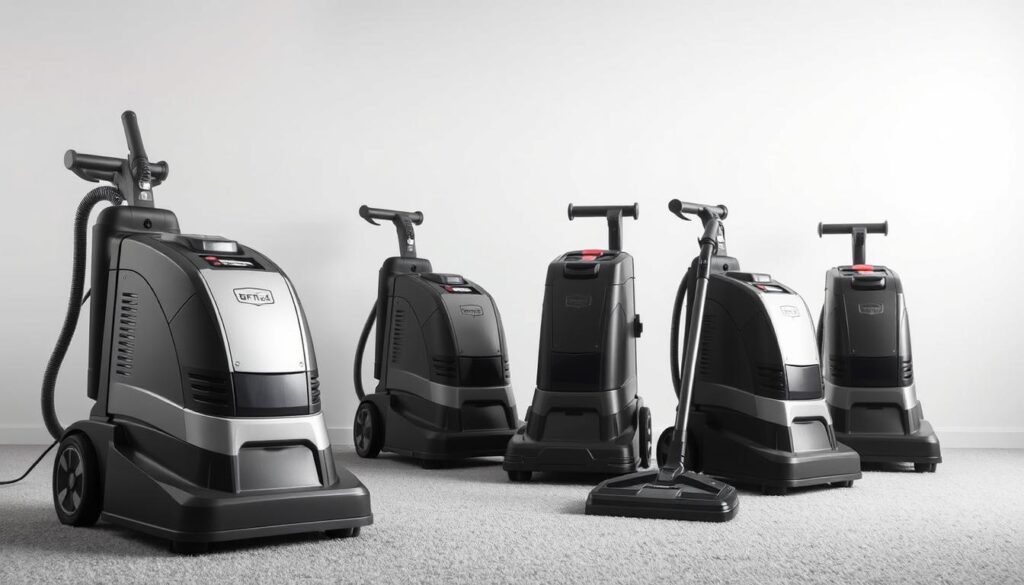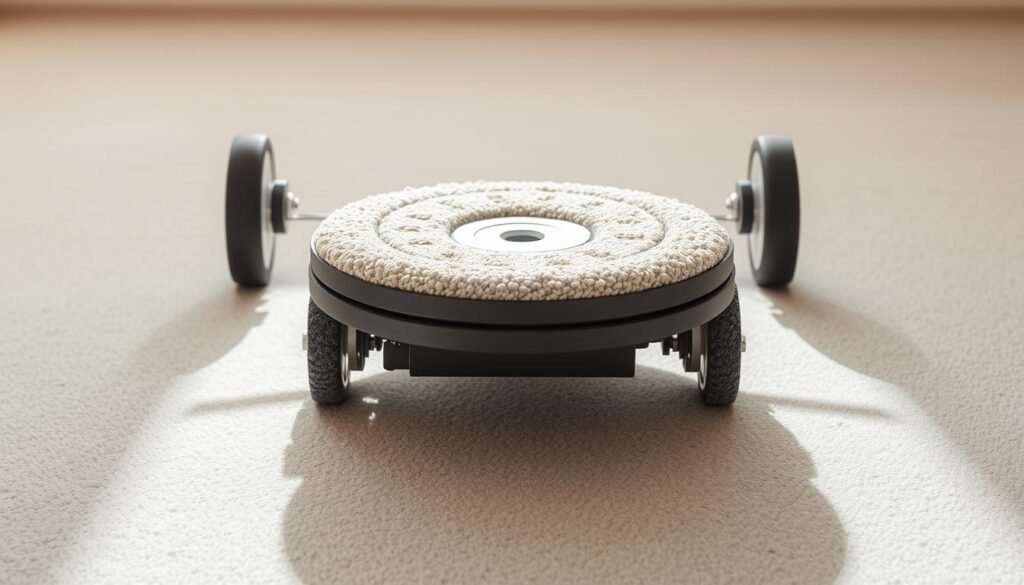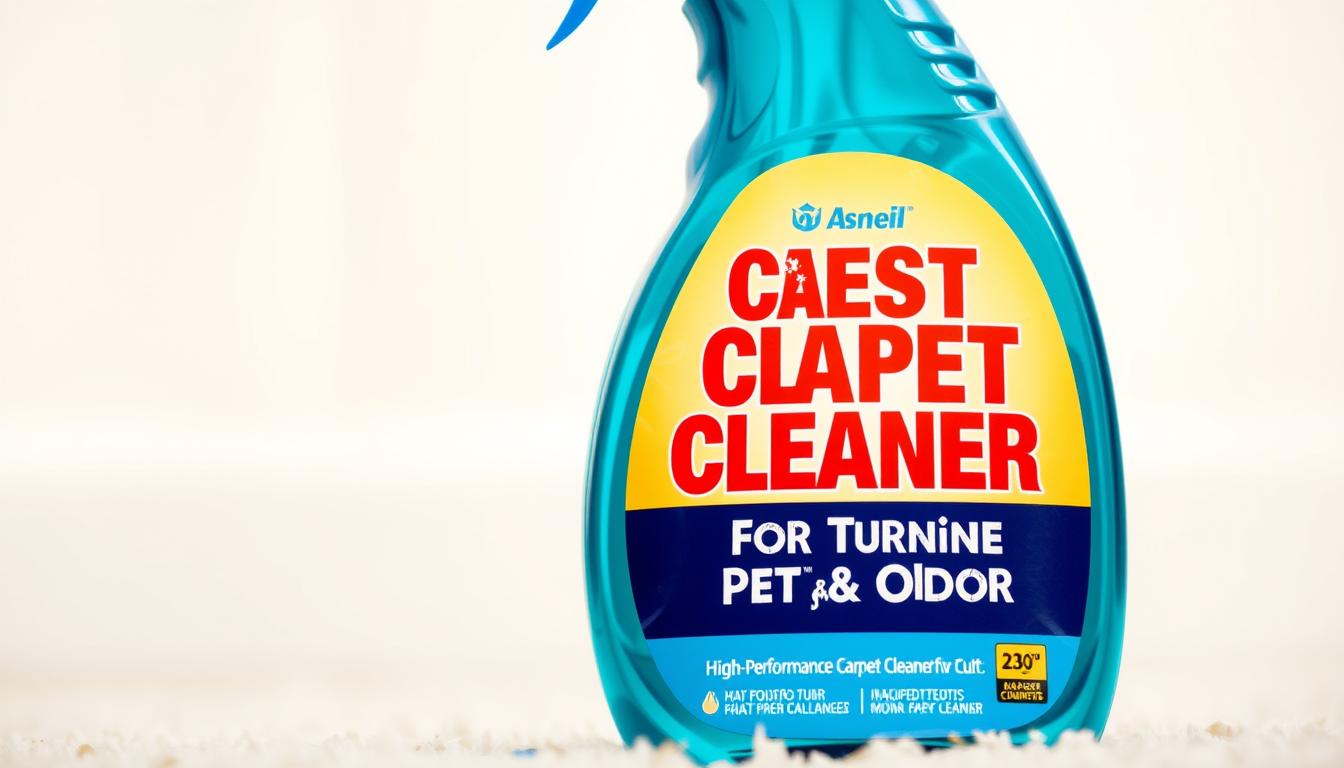You need a solution that removes smells, not just covers them. We tested sprays, shampoos, and machines in labs and real homes to see what truly works on fresh accidents and set-in messes.
Household tests and independent labs gave clear winners: OxiClean stood out for stains, Bissell excels at odor removal, and Tineco handled tough spots. Pros like Chem-Dry use UV checks and a targeted process to find and remove hidden urine molecules.
This guide shows which products suit quick touch-ups, deep cleaning, or when you should call a pro. You’ll get simple steps for blotting, treating, and drying so fibers stay safe and your space smells fresh fast.
Key Takeaways
- Lab and home tests reveal different strengths—pick by the mess type.
- Enzymatic vs oxygen formulas work differently; timing matters.
- Machines help with deep odor; sprays work for fresh spots.
- Follow safety notes to protect your pets and fabrics.
- Use UV checks or a pro service if odors return after cleaning.
Why you need a targeted carpet cleaner for pet urine and odor right now
Pet accidents aren’t just a visible mess—they create lasting chemistry. Urine breaks down into compounds that soak into padding and fibers, so smells often return even after surface stains look gone.
Acting fast reduces the chance the mess sinks deeper and saves you time and extra products later. Spruce Pets testing shows prompt treatment gives the best results, while enzymes need to stay wet to work.
Different types of stains need different action. Enzymatic solutions digest organic matter. Oxygen-based cleaners lift visible marks quickly. Choose by the mess: a dog splash differs from repeated cat marking.
- Targeted cleaning stops re-marking during potty training.
- Avoid ammonia or strong vinegar—these can attract pets back to the spot.
- Check labels against the EPA’s Safe Chemical Ingredients List and look for Safer Choice guidance.
If smells persist after home treatment, the pad or subfloor may be involved. That’s when deep cleaning or a pro scan with UV can find the hidden source and neutralize lingering odors for good.
Top picks at a glance to eliminate stains and smells
These selected sprays and shampoos won lab and home tests for speed and deep cleaning power.
Choose a combo that fits your needs: a fast spray for quick accidents, an enzymatic product to break down urine at the source, and a shampoo for full-room extraction.
Best overall spray: OxiClean Carpet & Area Rug Stain Remover
Why it stands out: lifted fresh stains and neutralized odors within 10 minutes. A second pass removed set-in stain in testing. Uses Safer Choice ingredients and has a mild scent.
Best enzymatic: Kids ’N’ Pets All-Purpose Stain & Odor Remover
Why use it: enzymes break down urine and vomit, especially when agitated. Leaves a light, fresh scent and can foam more than others. Good on fabrics beyond carpet, like mattresses.
Best scented option: Angry Orange Pet Odor Eliminator Spray
Why choose citrus: real orange oils provide a strong citrus deodorizing effect. Testers found it effective after overnight saturation; directions may call for scrubbing.
Best carpet shampoo: Nature’s Miracle Carpet Shampoo
Whole-room cleaning: enzymatic shampoo removed set-in stains in one treatment and works with extraction machines. Initial odor on application fades as it dries.
“Stock one fast-acting spray plus an enzymatic option so you’re prepared for both quick cleanups and lingering smells.”
| Product | Strength | Use case | Notes |
|---|---|---|---|
| OxiClean | Fast stain lift | Spot treatment on area rugs and carpet | Safer Choice, mild scent, two passes for set-in stains |
| Kids ’N’ Pets | Enzymatic breakdown | Urine and vomit, fabrics and furniture | Foams more; keeps a light scent |
| Angry Orange | Citrus deodorizing | Strong smells after overnight treatment | Uses real orange oils; may need scrubbing |
| Nature’s Miracle | Whole-room shampoo | Extraction machines and deep cleaning | Enzymatic; one-pass set-in stain removal in tests |
- Spot-test first to protect colors and fibers.
- Keep both a quick spray and an enzymatic option on hand for different messes.
- If a stain is older, expect to re-treat once or twice.
Best carpet cleaner for pet urine and odor: lab-tested winners
Testing showed clear divides between fast-acting sprays and deeper treatments.
Fresh stains usually come out quickly; older spots need more work.
Fresh vs set-in stains: what performed best in testing
In a controlled test of 31 products on beige carpet squares, fresh spills were easier to lift. Woolite INSTAClean erased fresh stains in under a minute in many trials.
OxiClean handled fresh messes in about 10 minutes and often required a second pass for set-in stain removal. Enzymatic options like Kids ’N’ Pets excelled at breaking down urine smells when you agitated the spot slightly.
Resolve Ultra Pet needed only a five-minute dwell to work on both urine and vomit analogs with minimal scrubbing. Nature’s Miracle shampoo removed set-in marks after one treatment, though it can smell strong while active.
Color safety and dry-time notes you should know
Always spot-test before full application to protect fibers and dyes. Top picks are generally safe, but carpets vary.
Dry-time depends on how much liquid you use and the formula. Follow label directions and plan a second pass rather than over-saturating a single application.
“A balanced strategy—quick spray for fresh spills and enzymatic or shampoo treatments for older stains—wins in most homes.”
| Product | Top strength | When to use |
|---|---|---|
| OxiClean | Quick stain and odor removal | Fresh spills; second pass for set-in stains |
| Woolite INSTAClean | Rapid spot removal | Immediate cleanups on carpets and rugs |
| Kids ’N’ Pets | Enzymatic urine removal | Old smells and organic stains with light agitation |
| Nature’s Miracle Shampoo | Deep room cleaning | Extraction when dealing with set-in stains |
- Plan ~10 minutes of dwell time for many products.
- Use microfiber to blot; avoid harsh scrubbing to protect fibers.
- If smells persist after treatment, the pad or subfloor may need attention.
Enzymatic cleaners that break down urine odors at the source
Targeted enzyme sprays work at a molecular level to remove what ordinary cleaners only mask. Enzymes digest uric acid and proteins so smells are gone, not hidden.
How enzymes tackle uric acid and proteins
Enzymes feed on the organic compounds in urine. They break molecules into tiny pieces that no longer smell. That stops repeat marking and reduces pet odors long term.
Timing matters: enzymes need moisture and dwell time to work. Re-wet older spots and cover to keep them active.
Kids ’N’ Pets vs Rocco & Roxie vs Biokleen Bac-Out
Kids ’N’ Pets is a budget-friendly option. Testers found it removed urine odors and vomit smell when you agitated the spot and let it sit. It can foam; just blot with a damp microfiber.
Rocco & Roxie carries CRI certification, so it’s safe on carpet and many surfaces. Users praise its reliability for repeated marking and messy areas.
Biokleen Bac-Out uses live enzyme cultures and botanicals. It has a mild lavender-lime scent and Green Seal credentials, though very old, set stains may need extra passes.
“Use an enzymatic pass first to neutralize odor, then follow with a lifting treatment if you still see a stain.”
- Enzymes remove the source of smells rather than masking them.
- Pair enzymes with extraction or an oxygen lift for visual stain clarity.
- Avoid vinegar or ammonia near enzymatic treatments; they can interfere and attract pets back.
Fast-acting sprays for fresh accidents
Quick sprays that act in seconds can keep a small accident from becoming a long-term stain. When you catch a spill while it’s still wet, a fast spot treatment saves time and prevents deep-set marks. Reach for a spray within minutes to control odors and visible damage.
Woolite INSTAClean: quick blot-and-go cleanup
Woolite INSTAClean removed fresh stains and odors in under a minute in testing. For tougher, set-in spots, a five-minute dwell improved lift; very stubborn mud sometimes needed a second or third pass.
Use it when you need an immediate fix: saturate the spot, blot with a microfiber, and repeat only if a color shadow remains.
Resolve Ultra Pet: simple pre-treatment
Resolve Ultra Pet worked well as a pre-treatment, eliminating urine and vomit stains after a five-minute dwell with minimal scrubbing. It foams during cleaning; rinse with a damp cloth and blot dry to remove residue.
Follow label directions and avoid over-saturating the backing or padding.
“Keep a fast spray on every level of your home so you can respond in seconds and stop odors before they set in.”
| Product | Speed | Best use | Notes |
|---|---|---|---|
| Woolite INSTAClean | Under 1 minute (fresh) | Immediate spot removal on area rugs and carpet | Five-minute dwell helps set-in stains; repeat if needed |
| Resolve Ultra Pet | ~5 minute dwell | Pre-treating urine and vomit before extraction | Foams; rinse and blot to remove residue |
- Always blot—don’t rub—to avoid pushing a stain deeper.
- Spot test dyes and finishes before full application.
- For light, fresh spots, a single pass usually suffices; improve airflow to speed dry-time.
Best carpet cleaning machines for deep pet odor removal
Machines that mix heat, suction, and steady flow make the real difference on lingering smells and set stains. If you have dogs or cats that mark or track dirt, extraction units pull water and residue from below the fibers where smells hide.
Bissell Revolution HydroSteam was the only machine in our test that consistently removed pet odors and dander. It ranked second for tough stain removal, has a 25-foot cord, pre-steam mode, and large tanks. Note: it’s heavier at 22.5 lbs.

Bissell Revolution HydroSteam: top at pet odor removal
The HydroSteam’s pre-steam setting helped lift smells better than competitors in our test. Large tanks reduce refill trips, but the weight makes stairs harder.
Tineco Carpet One Cruiser: tough stain removal, low noise
Tineco led on stain removal and was the quietest (~76.8 dB). Its AI detection and push-assist ease heavy work. It costs more and has smaller tanks, so expect extra fills on big rooms.
Hoover SmartWash+ FlexForce: easiest setup, fast drying
Hoover auto-doses solution, offers a dry-only pass, and has large tanks for full-room runs on one fill. Cord length is shorter and its odor/stain scores were average, but setup is simple and dry-time is quick.
Bissell Revolution Pet ProHeat 2X: budget-friendly, light use
This model is lightweight, quiet, and easy to store. It works well for light stains and routine cleaning, though it was average on heavy smells and set stains in our test.
Quick guidance: pick HydroSteam if pet odors are your main concern; choose Tineco for the toughest stain removal; opt for Hoover when you want easy setup and fast dry; go Bissell Pet ProHeat 2X for light, budget cleaning.
- Large tanks (HydroSteam, Hoover) mean fewer refill trips and faster full-room cleaning.
- Plan for weight and noise—top odor removers may be heavier and louder.
- If you train a dog or cat indoors, deeper extraction helps pull smells from padding, not just fibers.
- Finish with plain-water extraction passes to remove residue and reduce re-marking.
| Model | Top strength | Notes |
|---|---|---|
| Bissell Revolution HydroSteam | Pet odor removal, large tanks | Pre-steam mode, 25′ cord, 22.5 lbs |
| Tineco Carpet One Cruiser | Tough stain removal, quiet | AI detection, push-assist, smaller tanks, pricier |
| Hoover SmartWash+ FlexForce | Ease of use, fast drying | Auto-dosing, dry-only pass, large tanks, shorter cord |
| Bissell Revolution Pet ProHeat 2X | Lightweight, budget cleaning | Quiet, easy storage, average on heavy stains |
When to call the pros: Chem-Dry P.U.R.T. for set-in urine odors
A targeted pro process finds what you can’t see and treats it where it lives. If smells return after home cleaning, visible stains may be only part of the problem. Hidden deposits in padding or subfloor need detection and a different solution.
UV detection to find invisible urine deposits
Pros use ultraviolet light to map every affected area. That scan reveals marks you can’t spot in normal lighting so technicians know exactly where to treat.
P.U.R.T. molecular destruction and HCE deep clean
Chem‑Dry’s P.U.R.T. treatment penetrates carpet and pad, attacking odor‑causing molecules over 24–36 hours as it dries. Afterward, Hot Carbonating Extraction removes loosened soils and any urine crystals.
Why steam can worsen problems and when pro service wins
Steam can push liquids deeper and lock in smells. When urine has migrated into padding or subfloor, DIY sprays and many home machines can’t reach the source.
Call a pro when smells persist: they can detect hidden deposits, treat at the molecular level, and finish with extraction so odors don’t come back.
- Use pro detection before replacing carpet or repainting baseboards.
- P.U.R.T. also treats upholstery and mattresses when furniture is involved.
- After one professional reset, maintain with enzymatic spot treatment at home.
| When to call | Pro step | Outcome |
|---|---|---|
| Recurring smells after DIY | UV scan + P.U.R.T. | Molecule-level removal |
| Smell in traffic lanes/bedrooms | Targeted treatment + HCE | Deep odor removal |
| Furniture or mattress incidents | Upholstery P.U.R.T. | Stain and scent control |
How to clean fresh pet urine from carpet and upholstery
When an accident happens, focus on lifting liquid first, then neutralizing what’s left. Work calmly and keep steps simple so you don’t push the mess deeper into the backing or pad.
Blot, rinse lightly with water, then apply cleaner
Blot immediately with a dry microfiber or paper towels. Press firmly to lift liquid without rubbing; rubbing forces stains into fibers.
Lightly rinse the spot with cool water to dilute what remains. Avoid soaking the area — too much water spreads the stain into the pad beneath the carpet.
Apply a labeled stain odor remover starting at the edges and moving inward to limit spread. Follow the product directions and use minimal amounts on upholstery to protect cushions and backing.
Keep enzymes wet long enough to work
For enzymatic cleaning solutions, keep the treated area damp for the full dwell time. Cover with a lightly damp cloth so enzymes stay active and break down urine molecules.
After the dwell period, blot out excess, then do a plain-water pass to remove residue. This reduces the chance of re-marking and helps carpets dry faster.
- Repeat a lighter second application if the smell or stain persists rather than flooding the area.
- Use a fan to improve airflow and speed drying in the treated area.
- Keep a caddy with towels, a small bowl of water, gloves, and your go-to spray near problem zones for faster response.
Pro tip: check the spot under a black light later that evening to confirm no hidden stains remain and spot treat if needed.
How to tackle old, set-in pet urine stains
Old spots need a step-by-step approach that re-activates residues before you attempt full removal. Start by lightly re-wetting the area with cool water to loosen dried deposits. This helps any enzyme or stain odor remover reach the source.
Re-wet, re-treat, and extract—when two passes are worth it
After re-wetting, apply your enzymatic product and keep the area damp for the full dwell time. Agitate gently with a soft brush or microfiber to work the cleaner into the fibers, then blot.
If you own an extraction machine, run a clean-water pass to pull dissolved residue from the carpet and speed drying. Often a second, controlled application gives better results than one heavy soak.
At night, scan the area with a black light to test for remaining spots—urine will glow and show where another pass is needed. If odors persist after two disciplined attempts, the residue may be in the pad; call a pro to inspect and treat below the floor.
Tip: Avoid powders like baking soda on deep stains; they rarely solve the root problem and can harm fibers over time.
- Keep notes on which cleaners and how many passes worked on each area.
- Finish with good ventilation or a fan to ensure fast dry-time and prevent musty secondary odors.
Safety first: pet-safe ingredients, EPA Safer Choice, and ventilation
Before you reach for a bottle, check ingredients and air out the room. Good ventilation and a quick label scan protect your family and pets while you treat spots.
What to avoid
Avoid ammonia or strong vinegar. These smells can attract animals back to the spot and won’t neutralize the source. Skip powdered deodorizers like baking soda — they often embed in fibers and shorten lifespan.
Reading labels and EPA guidance
Always compare ingredients to the EPA’s Safe Chemical Ingredients List. Look for the Safer Choice logo from the American Cleaning Institute to pick gentler products.
“Rinse treated spots with a light water pass to remove residue and reduce re-soiling.”
| Risk | What to do | Why it matters |
|---|---|---|
| Strong ammonia/vinegar | Avoid use on treated areas | Can prompt re-marking by pets |
| Powdered deodorizers | Do not apply to fibers | May embed and reduce carpet life |
| Chemical residues | Rinse with light water pass | Reduces irritation and re-soiling |
- Use the least aggressive cleaning solution that works and spot-test first.
- Keep cleaners out of reach of children and pets until fully dry.
- If anyone has asthma, choose milder-scent enzymatic options.
Choosing the right cleaning solution for your home
Your home’s layout and who lives there should guide what you buy and keep in a caddy. Pick a mix that fits daily use: a quick spray for spots, an enzymatic option to neutralize sources, and a machine when whole-room refreshes are needed.
Dogs vs cats: dander, marking, and odor intensity
If you have a dog, plan regular traffic-area refreshes to cut dander and smells. For a cat, focus on neutralizing scent to prevent re-marking, especially along edges and vertical surfaces.
Apartments, rugs, and upholstery considerations
In tight spaces a quiet unit like Tineco helps; Hoover models dry fast when time is tight. Use multipurpose, CRI-certified products like Rocco & Roxie on rugs, upholstery, and furniture so one bottle covers many needs.
Allergies and sensitive noses: lighter scents and low-residue options
If someone is scent-sensitive, choose lighter enzymatics such as Kids ’N’ Pets or Biokleen Bac-Out. Reserve strong citrus deodorizers like Angry Orange for targeted high-traffic spots only.
Quick tip: rinse treated areas with a light water pass to reduce residue and keep stains odors from returning.
Our product testing approach and what “effective” means today
To judge products fairly, we reproduced common accidents on standard carpet panels and ran repeatable trials. That setup helps you see how each product works in real homes, not just in isolation.

Real-world messes: urine, vomit, mud on carpet squares
We used 24-by-24-inch beige squares split into quadrants. Each quadrant got one mess type: diluted wolf urine, a vomit analog (food broth with vinegar), or mud. Every product followed label directions with timed activation and dwell.
Scoring: ease of use, odor elimination, stain removal, value
Scoring covered how simple a product is to use, how well it eliminates smells, how fully it lifts stains, and whether it’s worth the price.
“Our process defines effective as repeatable, safe, and useful in real homes — not just a lab result.”
- Test steps mirror your cleanups: blot, treat, rinse when called for.
- We confirm results with sight, sniff, and a black-light follow-up.
- Machines were judged on odor removal, stain lift, noise, tank size, and dry-time.
| Part | What we measured | Why it matters |
|---|---|---|
| Spot sprays | Speed, ease | Quick fixes without soaking water |
| Enzymatics | Urine scent removal | Breaks down organic residues |
| Machines | Deep lift, dry-time | Removes residue from padding and fibers |
Pro tips to keep clean carpets between deep cleans
Keep your traffic lanes fresh between deep cleans with a few simple habits and the right tools. A short routine reduces wear, limits stains, and keeps odors from returning.
Tools to use: microfiber, soft brushes, and extraction
Keep a stack of microfiber cloths and a soft-bristle brush close by. They lift soils without harming carpet fibers.
Use a compact extractor or wet/dry vacuum for periodic maintenance pulls. Even one or two water-only passes can boost removal in high-traffic lanes.
Rinse and dry thoroughly to prevent re-marking
Rinse treated spots with plain water after cleaning to remove residual solution. Cleaning specialist Jessika James recommends this to cut chemical residue that can attract pets back to the same spot.
Prioritize airflow with fans or open windows so areas dry fast. Keep pets off damp areas until fully dry to avoid tracking and repeat stains.
Pro tip: skip powdered deodorizers like baking soda — they can clog fibers and do not solve underlying pet stains odors.
- Blot, don’t scrub, to protect texture.
- Rotate a fast spray and an enzymatic option depending on the problem.
- Note recurring zones; persistent smells may need deeper extraction or a pro visit.
Conclusion
Set a cleaning rhythm: respond fast to fresh spots, use an enzymatic option when urine is the source, then run a machine for periodic deep cleaning.
Keep it simple: stock OxiClean for quick wins, Kids ’N’ Pets to neutralize smells, and pick a machine that fits your needs—Bissell HydroSteam for odors, Tineco for tough stains, Hoover for quick dry, or Bissell ProHeat 2X on a budget.
Rinse treated areas, ventilate, and let places fully dry before pets return to reduce re-marking. If smells persist after honest effort, call Chem‑Dry for UV detection and P.U.R.T. molecular treatment.
Follow this playbook and you’ll see better stain removal, fewer recurring odors, and clean carpets that keep your home feeling fresh for you and your pets.


Leave a Reply